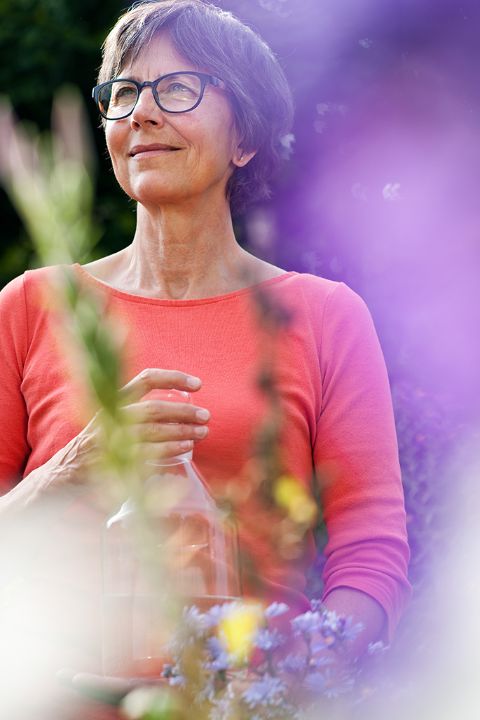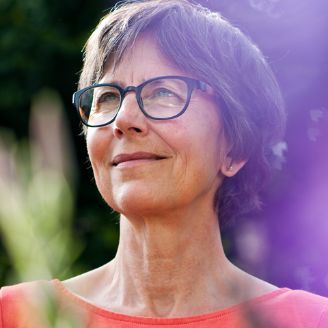
The Invisible Force
A sign reading “Potentisation Room” followed by the words “Please be quiet” and two exclamation marks hangs on the door. This may seem unusual in the production of medicinal remedies, but silence is a prerequisite for potentisation.
Neither routine nor machine define this process.
In this manufacturing process the medicinal substance is diluted with a mixture of ethanol and distilled water and then rhythmically moved by hand. When the potentisation process is under way in this room, it is clear that the doors must stay shut and that no one talks. The windows are fitted with a screen that provides privacy but lets in daylight, because good lighting is important for the process. But anything else that can cause distraction stays outside. That’s right, there are no telephones or computers in the room either.
A harmonious movement that is strong enough to make the liquid swirl around and bubble up is needed.
Helga Betz has been potentising for 30 years. Neither routine nor machine define this process. It is people like her who provide the necessary impulses here – in keeping with the idea of continuing the rhythmic processes of nature. This principle underlies what Betz calls the “triad” because the production of a potency is divided into three phases – dilution, rhythmitisation and rest. Today, an extract of Pulsatilla (also known as Pasque flower) from the Weleda herb garden is to be potentised. This process will be used to produce the original solution, or “mother tincture”. The D3 potency is required as an ingredient in the Weleda Cough Elixir. In a potentising bottle, a measure of the mother tincture is diluted with a mixture of ethanol and water in pre-defined proportions. Then comes rhythmitisation, during which the liquid is shaken back and forth in the bottle in a rhythmic motion.
The duration depends on the type and origin of the original solution, on whether it is a plant or mineral substance. Helga Betz sits on a stool, one hand held flat under the bottom of the bottle, the other clasped around its neck. Potentisation requires a harmonious movement that is strong enough to make the liquid swirl around and bubble up. Betz undertakes this process with intense concentration and a strong sense of responsibility; after all, she’s helping to give people access to healing remedies.
The end of the rest phase is always a special moment; a potency has been created
If the solution to be potentised weighs more than two kilograms, a so-called “potentising swing” is used. Betz puts the larger receptacle containing the mixture into the swing and then moves it back and forth by hand. For larger volumes, a potentising machine which is mounted on a track-like construction is used. The potentising vessel is moved back and forth in the same movement of its human potentiser, taking the heaviness out of the liquid and making it light.
Last but not least comes the third phase of the “triad”: the rest phase. This is the phase when Betz puts down the liquid and lets it rest. The end of the rest phase is always a special moment; a potency has been created. The Pulsatilla mother tincture now has the D1 potency; “D” stands for decimal. The Homeopathic Pharmacopoeia (in Germany, the HAB) generally stipulates a ratio of one part starting substance to nine parts liquid excipient for decimal potencies.
In the production of a D1 potency, the mother tincture-to-excipient ratio can vary depending on the concentration or content of the mother tincture, so that a different ratio may be prescribed. Since the Weleda Cough Elixir requires a D3 potency, the liquid needs to be potentised another two times. So one part of the D1 potency solution that has just been produced is diluted with nine parts of an ethanol and water mixture. A second rhythmitisation and then rest phase produces the D2 potency, and in the next step the D3. Each successive potentisation contains less of the starting substance. But according to homeopathic principles this doesn’t mean that the resulting substance is any less effective – on the contrary. The essential part of the starting substance – its information – presents itself in the potency as a force awakened by the rhythm.


Helga Betz : “I’ll never forget how I came to Weleda when I was in my early twenties and my boss asked me if I would like to try potentising. Even back then I had great respect for such a special task, which you can learn in a training programme offered by the company. In theory, the method can be quickly explained. A key aspect, for example, is to move the liquid around in a horizontal eight movement, which is the symbol of infinity. But the theory is just one aspect. Time and again in the more than thirty years I’ve been working here I’ve watched colleagues try out potentising and be surprised by how hard it is to bring the movement into harmony with your own rhythm. Although one colleague decided not to pursue it any further, in my case, it was different. I was able to connect with the process immediately. Am I really able to perform such an important task today? I have to ask myself this question every day. More than once over the years, the answer has been No. Then you do other tasks for a while, until you’re in a fit state to return to what you see as your calling.”









